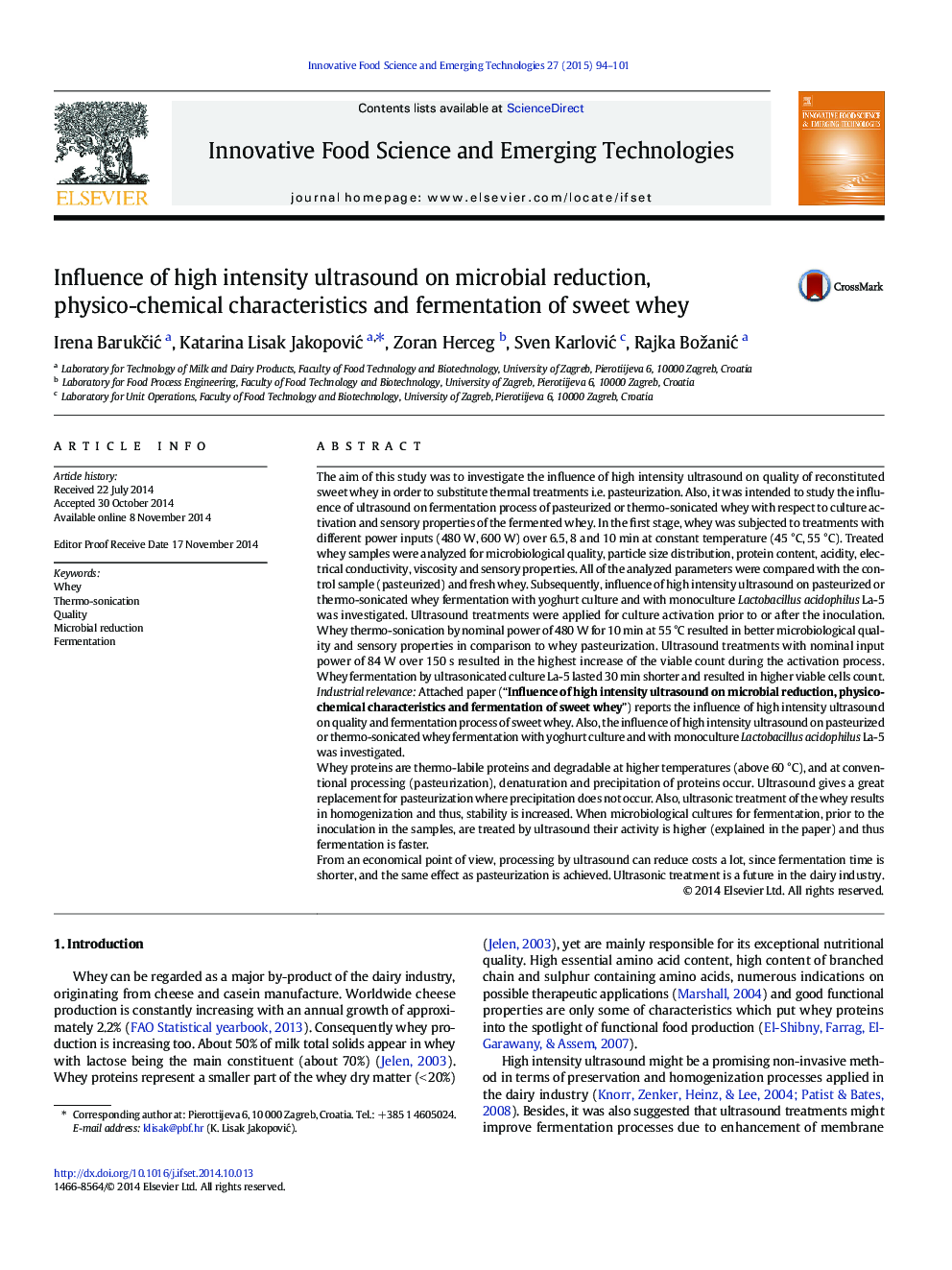| کد مقاله | کد نشریه | سال انتشار | مقاله انگلیسی | نسخه تمام متن |
|---|---|---|---|---|
| 2086511 | 1545539 | 2015 | 8 صفحه PDF | دانلود رایگان |
• Whey thermo-sonication resulted in better microbiological quality and sensory properties in comparison to pasteurization.
• Ultrasound treatments resulted in the increase of the viable count during the activation process.
• Fermentation by ultrasonicated culture lasted 30 min shorter and resulted in higher viable cells count.
The aim of this study was to investigate the influence of high intensity ultrasound on quality of reconstituted sweet whey in order to substitute thermal treatments i.e. pasteurization. Also, it was intended to study the influence of ultrasound on fermentation process of pasteurized or thermo-sonicated whey with respect to culture activation and sensory properties of the fermented whey. In the first stage, whey was subjected to treatments with different power inputs (480 W, 600 W) over 6.5, 8 and 10 min at constant temperature (45 °C, 55 °C). Treated whey samples were analyzed for microbiological quality, particle size distribution, protein content, acidity, electrical conductivity, viscosity and sensory properties. All of the analyzed parameters were compared with the control sample (pasteurized) and fresh whey. Subsequently, influence of high intensity ultrasound on pasteurized or thermo-sonicated whey fermentation with yoghurt culture and with monoculture Lactobacillus acidophilus La-5 was investigated. Ultrasound treatments were applied for culture activation prior to or after the inoculation. Whey thermo-sonication by nominal power of 480 W for 10 min at 55 °C resulted in better microbiological quality and sensory properties in comparison to whey pasteurization. Ultrasound treatments with nominal input power of 84 W over 150 s resulted in the highest increase of the viable count during the activation process. Whey fermentation by ultrasonicated culture La-5 lasted 30 min shorter and resulted in higher viable cells count.Industrial relevanceAttached paper (“Influence of high intensity ultrasound on microbial reduction, physico-chemical characteristics and fermentation of sweet whey”) reports the influence of high intensity ultrasound on quality and fermentation process of sweet whey. Also, the influence of high intensity ultrasound on pasteurized or thermo-sonicated whey fermentation with yoghurt culture and with monoculture Lactobacillus acidophilus La-5 was investigated.Whey proteins are thermo-labile proteins and degradable at higher temperatures (above 60 °C), and at conventional processing (pasteurization), denaturation and precipitation of proteins occur. Ultrasound gives a great replacement for pasteurization where precipitation does not occur. Also, ultrasonic treatment of the whey results in homogenization and thus, stability is increased. When microbiological cultures for fermentation, prior to the inoculation in the samples, are treated by ultrasound their activity is higher (explained in the paper) and thus fermentation is faster.From an economical point of view, processing by ultrasound can reduce costs a lot, since fermentation time is shorter, and the same effect as pasteurization is achieved. Ultrasonic treatment is a future in the dairy industry.
Journal: Innovative Food Science & Emerging Technologies - Volume 27, February 2015, Pages 94–101
